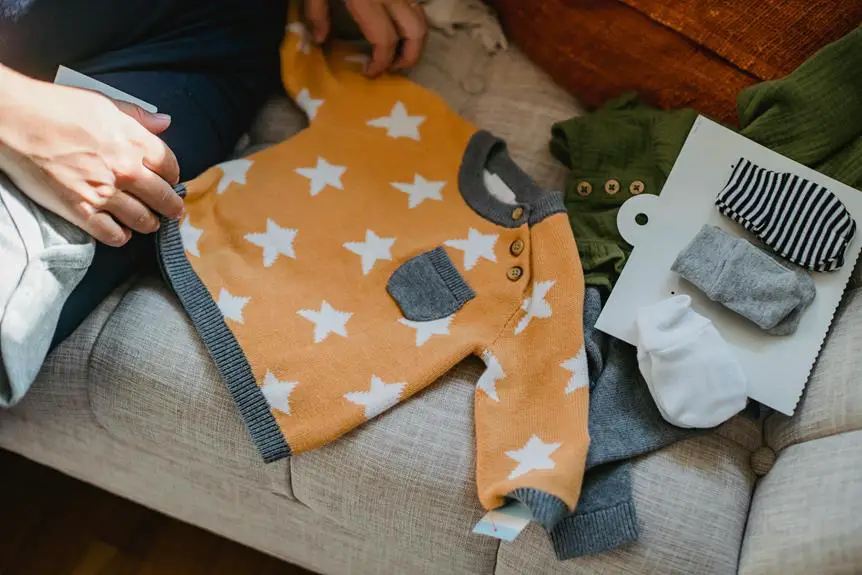When it comes to caring for taffeta garments, you need to be mindful of the delicate nature of this fabric. Gentle hand washing in cool water or professional dry cleaning can help maintain its elegance, but there are specific techniques you should follow to avoid damaging it. For instance, how you dry and store your taffeta can significantly impact its longevity. If you're wondering about the best practices for ironing or handling stains, the right approach can make all the difference in preserving that luxurious look.
Table of Contents
Understanding Taffeta Fabric
Taffeta is a crisp, smooth fabric made from silk or synthetic fibers, known for its lustrous finish and elegant drape. Often used in formal wear, taffeta's sheen catches the light beautifully, making it a favorite choice for evening gowns, wedding dresses, and elegant party attire. You'll appreciate its unique texture, which feels luxurious against your skin.
This fabric is lightweight yet has a structured quality that holds its shape well. Taffeta's stiffness allows it to create voluminous silhouettes, perfect for ball gowns and other structured designs. However, this same quality means taffeta can be prone to wrinkling, so handling it with care is essential.
When you choose taffeta garments, consider the occasion. Its formal appearance makes it ideal for special events, but it may not be suitable for casual outings. You might also want to pay attention to the fabric's weight; lightweight taffeta is more delicate, while heavier options can provide more durability.
Understanding taffeta's characteristics helps you appreciate its beauty and ensures you select the right pieces for your wardrobe. With proper care, taffeta can remain a stunning staple in your collection for years to come.
Cleaning Taffeta Garments
When it comes to cleaning your taffeta garments, you'll want to choose the right method to preserve their beauty.
You can either hand wash them gently or opt for professional dry cleaning services.
Each option has its benefits, so let's explore what works best for your specific needs.
Hand Washing Techniques
To keep your delicate taffeta garments looking their best, hand washing is the safest method to remove dirt and stains. Follow these simple steps to ensure proper care:
- Fill a basin: Use cool water and add a gentle detergent designed for delicate fabrics. Avoid harsh chemicals that can damage the taffeta.
- Submerge and agitate: Gently immerse your garment in the water. Swirl it around softly for a few minutes to allow the detergent to penetrate the fabric without excessive agitation.
- Rinse carefully: Empty the basin and refill it with cool, clean water. Rinse the garment gently until all detergent is removed, being careful not to wring or twist the fabric, which can lead to distortion.
- Dry properly: Lay the garment flat on a clean, dry towel, rolling the towel to absorb excess water. Then, reshape your garment and allow it to air dry away from direct sunlight.
Dry Cleaning Options
Sometimes, hand washing isn't the best option for maintaining the quality of your taffeta garments, making dry cleaning a viable alternative. Dry cleaning uses solvents instead of water, which helps prevent potential damage to the fabric.
When you decide to dry clean your taffeta, look for a reputable dry cleaner experienced with delicate fabrics. Before you drop off your garment, check for any stains and point them out to the cleaner. This way, they can treat the stains appropriately. It's also a good idea to remove any accessories, like belts or pins, to ensure the entire garment is treated properly.
When choosing a dry cleaner, ask about the methods they use. Some cleaners employ environmentally friendly solvents, which can be safer for both your garment and the planet. Always check the care label on your taffeta piece to see if it has specific cleaning instructions.
After your garment is cleaned, inspect it thoroughly before bringing it home. Make sure there are no lingering stains or damage. By opting for dry cleaning, you can preserve the quality and appearance of your taffeta garments for years to come.
Washing Techniques
Washing taffeta garments requires gentle handling to avoid damaging the fabric's delicate structure. To keep your taffeta looking its best, follow these essential washing techniques:
- Check the Care Label: Always start by reading the care label for any specific washing instructions. Some taffeta fabrics may have special requirements.
- Hand Wash: If possible, hand wash your taffeta in cool water with a mild detergent. This method minimizes agitation, which can cause damage.
- Avoid Soaking: Don't soak your taffeta for too long. A quick wash is sufficient to remove dirt and stains. Prolonged exposure to water can distort the fabric.
- Rinse Gently: After washing, rinse the garment gently in cool water until all detergent is removed. Avoid wringing or twisting, as this can ruin the shape and texture.
Drying Methods
When it comes to drying your taffeta garments, you'll want to focus on air drying techniques.
Avoiding direct sunlight is crucial, as it can cause fading and damage.
Let's explore the best methods to keep your taffeta looking pristine.
Air Drying Techniques
To ensure your taffeta garments retain their shape and finish, air drying is the best method to use after washing. This gentle drying technique helps prevent damage, maintaining the fabric's luxurious appearance.
Here are some effective air drying techniques you can follow:
- Hang with Care: Use padded hangers to support the garment's structure. Ensure the hanger isn't too wide, as this can cause stretching.
- Lay Flat: For delicate pieces, lay them flat on a clean, dry towel. This method avoids any stretching or distortion, especially for intricate designs.
- Use a Mesh Drying Rack: If you have a mesh rack, place your taffeta garments on it. This allows for proper air circulation, promoting even drying without creasing.
- Avoid Overcrowding: Whether you're hanging or laying flat, give your garments enough space. Crowding can cause wrinkles and hinder the drying process.
Avoiding Direct Sunlight
While air drying is important, it's equally vital to keep your taffeta garments out of direct sunlight to prevent fading and damage. Taffeta is a delicate fabric, and prolonged exposure to sunlight can lead to color loss and weaken the fibers.
When you're drying your taffeta pieces, find a shaded area where they can air dry naturally without the harsh rays of the sun. If you can't avoid sunlight entirely, consider using a clothesline or a drying rack that you can move to a shaded spot. This allows for proper airflow while protecting your garments.
If you're using a dryer, opt for a low-heat setting, but keep in mind that air drying is always the better choice. Additionally, if you notice that a taffeta garment has been exposed to sunlight for too long, take immediate action. Move it to a shaded area, and if possible, rotate it regularly to ensure even drying.
Ironing Tips
Using a low heat setting and a pressing cloth, gently iron your taffeta garments to remove wrinkles without damaging the fabric. Taffeta is delicate, so it's essential to take extra precautions while ironing to maintain its sheen and structure.
Here are some tips to keep in mind:
- Always use a pressing cloth: This acts as a barrier between the iron and the fabric, preventing direct heat damage.
- Iron on the reverse side: This helps preserve the fabric's finish and prevents shine from appearing on the front.
- Keep the iron moving: Avoid leaving the iron in one spot for too long, as this can scorch the fabric. Glide it smoothly over the surface.
- Spritz with water if needed: If wrinkles are stubborn, lightly mist the fabric with water before ironing to help release them more easily.
Storage Solutions
Properly storing your taffeta garments can help maintain their shape and prevent damage over time.
Start by choosing the right storage method. If you're hanging your taffeta pieces, use padded hangers to prevent creasing and maintain their structure. Avoid using wire hangers, as they can leave indentations and cause the fabric to lose its shape.
If you prefer folding your garments, make sure to use acid-free tissue paper. Layer the tissue paper between folds to help keep the fabric from crushing. Store the folded garments in a breathable garment bag or a cotton storage box to protect them from dust and light.
Avoid plastic bags, as they can trap moisture and lead to mildew, which is detrimental to taffeta.
Also, keep your taffeta garments in a cool, dry place away from direct sunlight to prevent fading and damage. If you live in a humid environment, consider using silica gel packets in your storage area to absorb excess moisture.
Handling Stains
When dealing with stains on taffeta garments, acting quickly can make a significant difference in the outcome. Here's how you can effectively tackle stains and preserve your fabric's beauty:
- Blot, don't rub: Use a clean cloth or paper towel to blot the stain gently. Rubbing can damage the fibers and spread the stain further.
- Use cold water: Rinse the stained area with cold water as soon as possible. Avoid hot water, as it can set the stain.
- Apply a mild detergent: Mix a solution of cold water and a gentle detergent. Test it on a hidden area first to ensure it doesn't harm the fabric. Dab the solution onto the stain using a clean cloth.
- Rinse thoroughly: After treating the stain, rinse the area with cold water to remove any detergent residue.
If the stain persists after these steps, consider taking the garment to a professional cleaner who specializes in delicate fabrics.
Quick action and the right techniques can keep your taffeta looking stunning!
Frequently Asked Questions
Can I Wear Taffeta in All Seasons?
You can wear taffeta in various seasons, but it's best in spring and fall due to its lightweight nature. In winter, layer it wisely, while summer might be too warm for its structure.
Does Taffeta Wrinkle Easily When Worn?
Yes, taffeta can wrinkle easily when worn, especially if you're sitting or moving a lot. To keep it looking fresh, consider adjusting your movements and choosing proper storage when you're not wearing it.
What Are Common Uses for Taffeta Garments?
Taffeta's commonly used for formal wear like evening gowns and bridesmaid dresses, as well as stylish jackets and skirts. Its crisp texture adds elegance, making it a popular choice for special occasions and events.
Is Taffeta Suitable for Formal Events?
Yes, taffeta's crisp texture and elegant sheen make it perfect for formal events. You'll find it commonly used in evening gowns and bridesmaid dresses, ensuring you look sophisticated and stylish for any occasion.
Can Taffeta Be Altered or Tailored Easily?
Yes, you can alter or tailor taffeta, but it can be tricky due to its stiffness. If you're unsure, consider seeking a professional tailor who understands the fabric's unique properties to ensure a perfect fit.
- How Does Ring Spun Cotton Affect Garment Fit and Shape Retention? - August 13, 2024
- What Are the Challenges in Producing Ring Spun Cotton? - August 13, 2024
- Is Ring Spun Cotton Suitable for Plus-Size Clothing? - August 13, 2024







